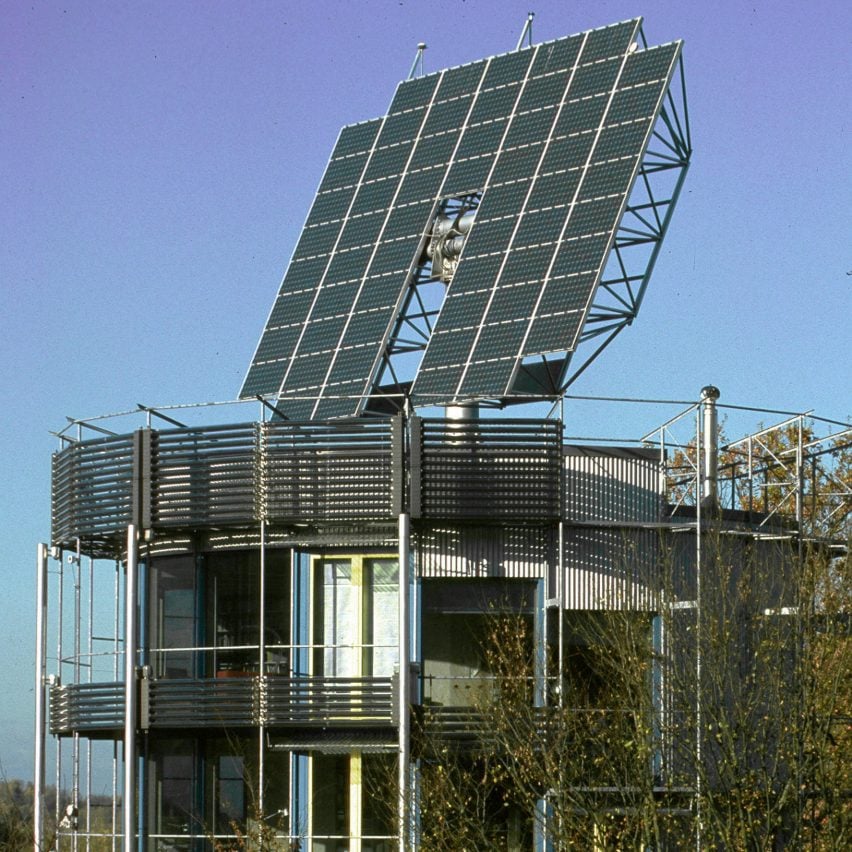A Solar Biennale exhibition has opened at the EPFL Campus in Lausanne, Switzerland, showcasing architecture designed to harness light, heat or power from the sun.
On show at EPFL’s Archizoom gallery, Sun Shines on Architecture spotlights buildings that embrace the sun in different ways, through passive solar heating, photovoltaic panels, greenhouses, oculus windows and more.

The show runs concurrently with a major exhibition at Mudac as part of the second Solar Biennale, which aims to support a global transition to solar energy.
Featuring drawings, models, photographs and archive material, the exhibition tells the story of solar architecture from past to present, in Switzerland and abroad.

Beginning in prehistoric times, it starts with a series of ritual buildings designed to function as giant sundials.
These include the pyramid at Chichen Itza in Mexico, which casts distinct shadow patterns when the sun is setting on the spring and autumn equinoxes. Also featured are the Pantheon in Rome and the Toghrol Tower in Rey, Iran.

The next section explores how the steel and glass of the industrial revolution paved the way for buildings to capture as much natural light as possible.
The Crystal Palace in London offers one example of a building flooded with daylight, while Villa Girasole in Marcellise, Italy, is a radical rotating house designed to move with the sun.

The third section celebrates a pioneering solar-heated home, the Dover Sun House built in Massachusetts in 1948, a project spearheaded by the so-called “sun queen”, Mária Telkes.
Solar technology becomes increasingly sophisticated from here onwards, as the show moves from the mid-20th century up to the present day.

There are infrastructure projects, like the Odeillo Solar Furnace built in France in the 1960s, as well as solar houses such as Rolf Disch’s rotating Heliotrope from 1994 and ComteMeuwly’s photovoltaic-topped Filter House of 2022.
Adaptive reuse is another key theme, with the recent overhaul of the 1970s Hirzenbach Housing Estate among the highlights. The revamp, designed by Lütjens Padmanabhan, added solar panels to the balcony fronts.
Buildings with integrated greenhouses also feature heavily, in a section filled with 3D printed models and plans.
The exhibition was curated by Archizoom director Cyril Veillon, with the aim of showing how the sun can become an intrinsic part of an architectural design.

“Sun Shines on Architecture analyses how this source of energy, whether used passively or actively, is becoming a real architectural element in any renovation or new-build project,” reads the exhibition text.
“Faced with global warming, these technical and poetic challenges are being reaffirmed.”

The Solar Biennale was founded by designers Marjan van Aubel and Pauline van Dongen, to support a global transition to solar energy.
The first edition took place in 2022 at the Nieuwe Instituut in Rotterdam, the Netherlands, which staged an exhibition called The Energy Show.
Van Aubel and van Dongen hope to initiate future editions of the Solar Biennale in other countries around the world.
Sun Shines on Architecture is on show at Archizoom from 21 March to 21 June 2025 as part of the Solar Biennale. See Dezeen Events Guide for more architecture and design events around the world.
The post Sun Shines on Architecture exhibition celebrates solar buildings from across history appeared first on Dezeen.

